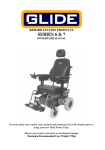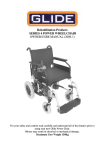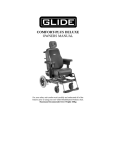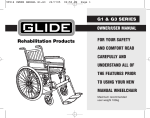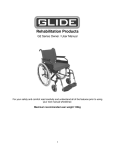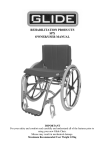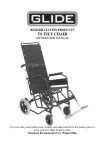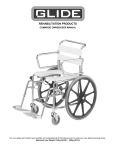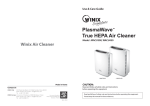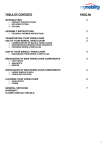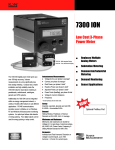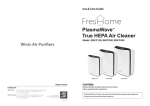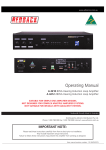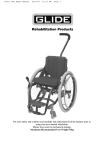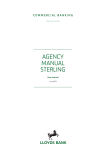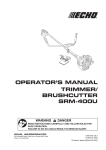Download Centro
Transcript
OWNER/USER MANUAL V 3.0 IMPORTANT For your safety and comfort read carefully and understand all of the features prior to using your new Centro Powerchair. Misuse may result in electrical or mechanical damage. Maximum Recommended User Weight 175 kg 1 Table of contents Section 1. Introduction P3 Section 2. Standard features P4 Section 3. Warnings for care and occupant P5 Section 4. Operating your wheelchair P9 Section 5. User training and setup P 14 Section 6. Transporting of wheelchair P 15 Section 7. Battery charging and maintenance P 16 Section 8. Care and maintenance P 20 Section 9. Trouble shooting P 22 Section 10. Precautions for controller use P 23 Section 11. Transfer to and from your wheelchair P 25 Section 12. Centro Vertical Lift seat model. Warning! P 26 Section 13. Warranty P 27 Section 14. Spare Parts P 28 Note: Specific Controller information and controller operators manual will be supplied separately to this manual. 2 Section 1. Introduction Thank you for choosing the Centro Power Wheelchair. An Australian designed and manufactured product, which complies with AS-3695 – 175 kg and Crash Tested to AS-3696:19. With proper care and operation your wheelchair will provide years of trouble free mobility. Please take the time to familiarise yourself with the functions and features of your power chair by reading this owners manual. If you have any queries about the functions of the chair you can call Glide Products or your nearest Glide Products dealer. If you have a Vertical Lift model, it is essential you read and fully understand Section 12 before use. GLIDE REHABILITATION PRODUCTS 25 LEDGAR RD BALCATTA PERTH. WA. 6021 AUSTRALIA PH: +61 8 9345 3400 Fax: +61 8 9345 1384 3 Section 2. Standard features Fig 1 The illustration above lists the standard features of the Centro Power Chair. 1. 2. 3. 4. 5. 6. 7. 8. 9. 10. 11. 12. 13. 14. 15. Back Rest Canes Arm Rest Arm Rest height adjustment knob Rear Transport Tie Down point 6” rear Castor wheel Attendant Park Brake Drive clutch 14’ Drive wheel 8” front castor wheel Front Transport Tie Down point Foot plates Leg Rest release latch Leg Rest Hanger Joystick Module Backrest 4 Section 3. Warnings Read and understand the warnings stated in this section. To the User WARNING! 1. Before using this chair, obtain advice and training from your Health Professional. 2. Each chair is custom designed to suit individual needs. Take time to become familiar with each feature before you begin driving. 3. Depending on your level of function and ability, you will need to develop your own methods for safe use. 4. Understanding the environment where the wheelchair will be used will help identify potential hazards and how to avoid them. 5. Read this manual in full before operating chair. 6. Never take wheelchair onto stairs or escalators. To the Carer 1. 2. 3. 4. 5. 6. 7. WARNING! You must read this manual and follow all the instructions in each section as they also apply to you. Never use power operated options such as Vertical Lift, Power Elevators unless occupant and bystanders have hands well clear of operation. Drive clutches should be engaged at all times while occupant is seated. When drive clutches are disengaged there is no braking when manoeuvring wheelchair To manually push the chair you must make sure that you have control over the wheelchair before releasing the motor drive clutch. Only manually manoeuvre wheelchair on level ground while occupant is seated in wheelchair. Never manually manoeuver wheelchair up and down ramps whilst occupant is seated in wheelchair. You must develop an understanding of the occupants ability to develop safe methods best suited to your ability Only use the push handles to move chair. They are specifically designed for this purpose When helping the occupant overcome an obstacle you must: • Learn safe methods from your health professional • Explain clearly to the occupant what you are about to do and what they are required to do • When traversing curbs or steps always approach square on. Never attempt angled approaches as this may damage castors. 5 8. Never take chair on to stairs or escalators. WARNING! Environment Conditions The Glide Rehabilitation Products Power Chair has been designed and tested with user safety, as its prime consideration. The “Active Posi Trak” (APT) Suspension System has been designed to automatically adjust to uneven surfaces and changes in height, allowing all six wheels to stay in contact with the ground under most conditions. This feature provides improved stability and increased traction on drive wheels in demanding situations. Even though the “Active Posi Trak” System improves manoeuvrability and stability, this does not negate the effect or take into account, circumstances, which put the wheelchair outside the specified operating conditions for which it was designed and tested. It is important that the user takes due care and understands the limitations within the environment that the chair will be operated. As a guide only, the following is a brief list of scenarios that could affect the stability of the chair and need to be considered when driving chair: • • • • • • • • • • • • • • • Always turn the controller off when parked. Even it is only for a short time as this will prevent accidental movement of chair or release of park brakes. Traction could be lost on inclined or decline if wet and grassy surfaces. Take extra care and drive slowly on these surfaces. Extreme Tilting and reclining must be done on level ground ONLY. Chairs fitted with Tilt and Recline features should be NOT be driven with these features in a extreme Tilt or Reclined position. Driving in a Tilted or Reclined position can affect stability and your vision. Never drive your chair on a wet, oily or icy covered ramp or slope Stop if one or both drive wheels loses traction Never traverse railway lines without someone in attendance Wheelchair should not be driven in heavy rain Never use your chair in a shower, swimming pool, sauna, ocean or lake. If your environment has many steep obstacles, always have someone in attendance to assist you. Never drive your wheelchair in sand or over rough surfaces. Apart from get stuck you may also cause damage to wheels, bearings, gearboxes and motors. Maximum safe slope – facing up slope 15 degrees Maximum safe slope – facing down slope 15 degrees Curb climbing should not exceed 80mm when level. Do not climb if already on slope. Curb descending should not be more than 100mm when level. Do not descend if already on slope. 6 • • Always approach curbs square on. Never on an angle. Castor will spin and lock if approach angle is not 90 degree. Whilst driving, the ON/OFF switch on the controller should only be switched OFF in an emergency. The wheelchair will come to a fast controlled stop rather than sudden stop. Ramps and Inclines WARNING! When your chair is on a ramp or incline the centre of balance of your chair will change. Your chair is less stable when on ramps or inclines and should not be used unless you feel it is safe to do so. If in doubt have someone with you. Do not use the chair on a slope of greater than 15 degrees. When ascending a ramp: (going up) • • • • • • • • Make sure power tilt seat is in the down or flat position and the backrest is in the upright position. Never attempt climbing ramps with high degree of seat tilt. Approach the ramp or incline straight on. Do not approach on an angle (cut the corner) Make sure that you are in the centre of the ramp and that the ramp is wide enough for your wheelchair Do Not use ramp if you feel that a wheel may drop off the side. Do not veer or turn while on ramp. This may cause chair to tip and a fall may result. Drive wheelchair at a slow, steady speed. Keep chair moving. Return tilt and recline to normal driving position when back on level ground. When descending a ramp: (going down) • You should raise the power seat tilt to a suitable angle to compensate for the ramp angle. The seat angle should in a near level position when on the ramp or even better slightly raised. This will reduce the chance of your body falling forward when travelling down a ramp. • Re-adjust seat tilt angle to your normal drive position when back on level ground. • Always use the centre of the ramp. • Do not veer or turn while on ramp. • Drive wheelchair at a slow steady speed .Do not allow chair to accelerate over normal speed. Centre the joystick to allow it to slow down or stop. • Never use attendant brakes to slow or stop the chair. This may cause the chair to veer or change direction erratically. 7 RFI. Warning WARNING! All electronic devices generally radiate some type of Radio Frequency Interference (RFI). The manufacturer of the wheelchair control systems, have made every effort to minimise the effect of RFI so as not to cause problems under normal circumstances. Even with the efforts by the manufacturer to minimise effects of RFI, the chair control system may still be affected in areas with strong RFI signals. If for any reason, your chair behaves in an abnormal manner, shut the wheelchair off immediately. Before continuing, the user must be confident that the system is performing normally. If not, turn chair off and contact your carer or Glide Rehabilitation Products Agent for repair. Controllers WARNING! Your wheelchair has been supplied with a fully programmable controller, which has the ability to fine-tune many driving parameters using special equipment and a PC. At time of specification your chair would have been programmed to best suit your individual function and ability. Drive the chair in the mode and speed level that best suits the environment so as not to cause injury to yourself or others. Have an authorised Glide Rehabilitation Products agents make adjustments to the controller if the chair is not performing to your satisfaction. There are no controller adjustments that can be made by the user or carer apart from speed level selection. Safety/Performance Check WARNING! Make sure the chair operates as it is designed to do. If there is a change in the performance of the wheelchair or in your functional ability, contact your nearest Glide Rehabilitation Products agent to reprogram the control settings to match your needs. It is advisable to have these settings checked annually. Check for any uncharacteristic noises, vibration or any difficulty in its use. If a problem is found, notify your carer and Glide Rehabilitation Products agent for repair or advice on how to repair. Do not drive it if your safety is at risk Make sure that the batteries are fully charged before operating. Make sure all tyres are inflated to recommended pressures and in good condition Make sure all accessories are secure and in correct position Check that the electronic brakes work correctly. (When chair is switched ON with drive clutch engaged and hand off the joystick, the wheelchair should not be able to be pushed.) 8 Modifications WARNING! Never make any modifications or use non-approved Glide Products parts on your power chair. Doing so may cause a safety hazard and could void Warranty. Unauthorised changes constitute remanufacturing of the power chair. This voids any warranty. The person or group who make the changes will have full liability of the power chair. Section 4. Operating your Powerchair. Controller Your new Power Chair has the option of two types of control systems, Dynamic Controls or PG Controls. You will have been given instruction on how to operate your controller at time of specification or on delivery. As most power wheelchairs are setup with Drive parameters to suit individuals and needs, we will only cover the basics in this manual. WARNING: Never push the On/Off button or pad on the control box until you are seated correctly in the chair and have your hand on the control box. IMPORTANT: Please familiarise yourself with the individual functions of your controller in particular the On\Off button or pad. Both types of control systems have an On/Off button or pad that operate by pressing once for ON and pressing the same button or pad again for OFF. 1. 2. 3. 4. 5. 6. Do not displace the joystick when pressing the ON button. An error will occur and you will have to turn controller off and then back on again. Always set Speed selection to suit environment. Indoor driving should be set to a lower top speed. Driving on highly polished floors can be slippery. Lower the Speed setting to half or even less if required. Unless in an emergency, never press the On/Off button while driving your powerchair. Never hang items on the joystick. (E.g. shopping bags) To avoid damage to motor gearboxes always come to a complete “stop” before turning your power chair off. 9 DRIVING When driving the wheelchair for the first time you should always start with the slowest speed setting and gradually increase as you get accustom to your wheelchair. The seat should also be slightly tilted (approx. 8 degrees) for best driving performance. Never drive your wheelchair when seat tilt is set flat or zero degrees as this puts extra load on front castors and will prematurely wear castor tyres and may also interfere with ground clearance of foot plates or foot plates interfering with castor wheel. Armrests The Flip up armrests are adjustable in height, position forward or aft of arm pad. These can be permanently set in the desired position and locked with bolts or user adjustable using locking knobs or thumb knobs. To adjust height, loosen Turn Knob located on outside of armrest Post. When adjustment is complete retighten Turn knob firmly. Forward and Back Adjustment of Arm Pad Loosen small turn knob located on the outside and underneath arm pad. Retighten when adjustment is complete. Do not undo more that one turn. This knob also allows adjustment of joystick module. Flip Up Armrest Lock Located on the inside of the armrest mount bracket. Pull knob out and turn 90 degree. This will allow armrest to move freely up and down. To lock, turn knob 90 degrees and allow knob to drop in. Drop armrest down and arm should be in the locked position. 10 Legrests and footrests The footrests are swing away and detachable. They swing out by pulling the release lever. When lever is released, the footplate will simply swing out and lift off the two locating Pins. When refitting footrest to wheelchair ensure that it is located on both locating pins. Damage may result if only one pin is used. Once the legrest is on the locating pins and with foot plates up, swing legrest towards centre of chair firmly so latch will click into position. Height Adjustment of Footplate Your footplate will be fitted with one of two types of adjustment styles. 1. Clamp Type–to adjust height simply loosen clamp bolt, move to desired position, retighten clamp bolt. 2. Incremental Hole Type–to adjust height simply un - do and remove bolt, move footplate to nearest hole to suit desired height, replace and tighten bolt firmly. 11 Drive Clutch The drive clutch is located in the centre of each driving wheel. It is identified as a large Black Knob with grip rings. 1. Drive Clutch (shown disengaged) To ENGAGE, simply turn Black Knob (Drive clutch) in either direction until you here a “click”. Turn chair on and SET AT SLOWEST SPEED and then SLOWLY move joystick forward until drive clutch self engages. When clutch is engaged fully, the outer face of the Drive clutch will be flush with the retainer washer. To DISENGAGE simply pull out drive clutch and turn 1/8th of turn or 45 degrees to locate clutch in the disengaged resting position. This will allow the chair to be free wheeled. You may need to take some load off the Drive clutch by moving the Drive wheel by hand slightly forwards or backwards at the same time as pulling out Drive clutch. Brakes Your power chair has electronic brakes and they are activated in the flowing manner. 1. If chair suffers a power failure while driving 2. When joystick of controller is released 3. When chair is turned Off 4. Drive clutches should remain engaged at all times and should only be disengaged when manually push wheelchair. The electronic brakes are static brakes only and the wheelchair controller will use the motors for slowing the wheelchair before the electronic brakes are automatically activated. 12 In addition the power chair is fitted with attendant static brakes for use when stationary. These should be used by an attendant when transporting in vehicle or when securing the wheelchair. Adjusting the backrest angle There are 2 options available for backrest angle adjustment 1. Standard on all Centro’s wheelchairs, unless otherwise ordered, is an incrementally adjustable Back Rest canes via Armrest/Back Canes bracket. It is advisable to have a Glide agent or trained Technician to make this adjustment. 2. Electrically operated actuator. These are operated in several ways • Button located on controller in conjunction with joystick. • Remote switches located for best access by occupant. • Please refer to respective Controller manufactures user guide for more info. Please familiarize yourself with this function for trouble free operation. Adjusting the seat angle 1. Electrically operated actuator. This is operated in several ways • Button located on controller in conjunction with joystick. • Remote switches located for best access by occupant • Changing to actuator on MODE setting and using joystick to adjust. • Please refer to respective Controller manufactures user guide for more info. Please familiarize yourself with this function for trouble free operation 13 Section 5. Wheelchair set up and training Setup Setup and user training of this wheelchair should be done by a Health Professional and with the aid of manufactures selling agent. Your wheelchair may be fitted with a third party seating systems and may differ from this manual. Positioning Belts The use of positioning belts is highly recommended as it will help support the occupant and also prevent occupant from falling. The use of position belts must ONLY be setup by Health Professional. Improper use of positioning belts may cause serious injury. WARNING! Positioning belts are not to be used as a seat belt when occupant/wheelchair is transported in vehicle. Please refer to Section 6 Transporting Your Power Chair WARNING! Today, there are many seating systems on the market to fit a multitude of wheelchair types and brands and also to suit individual a needs and preference. The Centro has been designed to accommodate many of these systems including Glide’s own. Because of the varying nature of these systems and possible changes to the centre of gravity, it will be necessary for a Health Professional with the aid of the selling agent representative to insure the wheelchair is set up safely. Power Seat Tilt Your wheelchair will more than likely have a 50 degree power seat tilt which is a common recommendation by Health Professionals today. Whether you tilt your seat to the full extent is entirely your choice but you should be trained in its use and learn to feel safe with this features. The wheelchair will not drive once it has passed 22 degrees and will have to be returned back to a safe level before being able to drive gain. The wheelchair must always be on a level surface when tilting passed the 22 degree mark. Power reclining Backrest Your Health professional may have prescribed a power reclining backrest with this wheelchair. The user should be trained for the use of this feature and should feel comfortable with its operation. 14 Other Options Your wheelchair may also have other powered operated options fitted to your wheelchair. You must be trained by you Health Care Professional or Selling Agent Representative before using any of these options. These could included: Power Elevating Legrests Vertical Lift Raise Seat. (Refer Section 12) Power Swing away Chin Control Unit WARNING! Before using any power operated option, ensure everyone is clear of wheelchair as pinch points may inflict serious injuries. 15 Section 6. Transporting your power chair Transporting your Power Chair in motor vehicles can be easily achieved by the following methods. Transporting in a special wheelchair taxi, bus or private vehicle while the user is in chair. The Centro wheelchair has been tested and passed crash test (AS 3695 part 19). Vehicle tie down points are positioned front and rear of the wheelchair. Use only suitable and approved tie down system complying with AS2942-1994 . We used and recommend the Unwin vehicle tie down system in accordance with manufactures specifications. CAUTION: Do not use leg rests, armrest, footplates or any other area apart from the designated points as attachment points for your tie down system. Unoccupied wheelchairs in vehicles must be safely secured or stored securely outside the passenger compartment. Posture Positioning Belts must not be used as vehicle restraint belts. NOTE: Ensure that your restraint system complies with AS2942 and you fully understand the manufacturer instructions on how your tie down system works and whether it is compatible with the Glide Power Chair 16 Section 7. Battery charging and maintenance Keeping the Power Chair working to its maximum potential, it is recommended the batteries be charged every night. This will ensure a longer life for the batteries and ready to go when you are. Your Powerchair battery charger is specific to your wheelchair and may not be suitable for other Powerchairs. Only use the charger supplied with your wheelchair. The use of third party chargers may damage or shorten the life of your batteries. When is it time to replace Batteries On average, you should get up to 12 months life from your batteries before the need for replacing. This is a guide only and depends on many factors including proper charging each night. As the batteries deteriorate you will notice that the batteries are not lasting as long between charges and eventually you will need to replace as a full charge may only last a couple of hours or less. Charging your power chair 1. 2. 3. Ensure charger is switched off Ensure wheelchair controller is switched off. Connect charger to wheelchair via the charging socket located on the front of the joystick module. Charging Operation Please refer to specific charging operating instructions supplied with your wheelchair. Charging times Charging times may vary depending on usage, battery condition, internal resistance and age of battery. In most cases overnight charging (8 – 10 hours) is sufficient. No harm will be done to batteries by leaving them on charge for a few days. However prolonged charging is not advisable. Eg. 3 days or more. Batteries Care and Storage 17 Do not store near a heat source or in direct sunlight. Keep the terminals dry, clean and coat lightly with petroleum jelly to prevent corrosion. Batteries must be fully charged every 3 months if not in use. Battery installation and removal Battery installation should be carried out by qualified Technician. 1. Remove footrests and set Seat Tilt to approx. 20 degree. If no batteries installed, discount seat actuator cable from Power module or ISM and using suitable connection cable, connect seat actuator to battery (12v is ok) and operate actuator until seat tilts to 20 degrees.. 2. Remove 4 securing blots holding down Seat Base module. 3. Apply Park Brake and using Back Cane push handles, tilt seat base forward. Remove battery cover and attached security hook as illustrated below. 4. Unscrew and remove circuit breaker. 5. To avoid accidental shorting of batteries when installing, ensure terminal protection caps are installed. If not, then use insulation tape and cover all terminals. 6. Orientate front battery and lift into back of Battery Box and slide forward. Orientate rear battery and lift into battery box. Secure battery using tie down bolts and clamps 7. Connect all wires in accordance to wiring diagram page 20. 8. Once completed, detach security hook and swing hook to back of chair and locate in holder. Insert plastic Battery Cover on top of batteries (ensure correct orientation) and lower Seat Base back down to chassis. Insert 4 bolts into base plate and chassis and tighten nuts. Please adhere to Battery installation Warnings on page 20 Note: Vertical Lift seat models (post 2013) will hinge from rear of wheelchair. 18 WARNING! Plastic Insulation cover must be installed at all times as illustrated page 18. Ensure rubber base mat is in place. Ensure battery connectors are secure and Battery Hold Down bolts are tight using Nyloc nuts. WARNING! Hinged Seat Base models Seat Base must only be hinged forward to remove or insert batteries. For your safety, never attempt any other maintenance work to wheelchair other than battery installation whilst Seat Base has been hinged. Damage to hinge may occur. Battery type and size Only use batteries with a total combined weight of 40kg or more. Your wheelchair was designed for optimum balance using batteries of this weight. Replacing batteries with smaller or lighter batteries such 50amp/hr batteries may change the balance of the wheelchair. Recommended Battery Battery Type: GEL Sealed Lead Acid - Deep Cycle 2 x 12v 70amp/hr approx weight each 24kg. Maximum Battery dimension: 260L x 171W x 220H Do not use batteries weighing less than 20kg each. WARNING! Note: Please refer to battery wiring diagram page 20. The plastic insulating Battery Cover must be in position before securing Seat Base module to chassis. Never leave out plastic insulating cover plate as electrical short or fire could occur if batteries become dislodged. If you believe your batteries are not properly secured or have come lose over time, cease driving your wheelchair and have it checked by a service technician. Consult your Glide Agent if battery replacement is required. 19 Battery Wiring Diagram Note: If warranted, packing blocks could be used to limit battery movement as batteries come in varying shapes and sizes. 20 Section 8. Care and routine maintenance The Centro power wheelchair has been design for minimal service requirements and will give years of service if used correctly. Daily Charge your batteries every night so your Powerchair is ready to go when you are. Check first up each day that your chair drives as it should. If your wheelchair suddenly drives or reacts differently, it generally means something is wrong and you should cease using the wheelchair until it has been check by a Technician. It could be something simple as a flat tyre or could be something more serious. Weekly 1. Check tyre pressures (30 PSI drive wheels, 30PSI front castors) 2. Clean frame and vinyl parts with mild soapy solution. 3. Wipe upholstery with a clean damp cloth Check function of electric brakes (When chair is turned on with motors engaged and hand off the joystick, you should not be able to push the chair or rotate the drive wheels) If wheelchair can be moved, do not operate wheelchair and get a service technician to rectify immediately. 4. Check all cables for possible damage and ensure all connectors are secured; i.e. battery, motors and controller. 5. Check both front and rear castors for any excessive movement about the top or bottom bearing mounts or pintle shaft. Contact your nearest Glide Products agent for repair of this fault if it occurs. BOLTS The bolts on your wheelchair are mostly made from high tensile steel (Black Oxide coated). Although the black oxide coating gives reasonable protection from surface rust, it is recommended that the bolts be wiped with a cloth using either an oil base or silicon base rust preventer to keep bolts looking new. Other rust preventive that can be used are Armor All, WD40 or CRC . Monthly 1. Give the chair a general inspection for loose nuts and bolts or any damage. 2. Check attendant park brake is operating correctly. Six monthly 1. Extreme users should have the two front suspension pivot points greased every six months. There are two grease nipples clearly visible on the end of the pivot shaft. Otherwise annually will be sufficient. 21 Recommended Grease Type: Molybdenum disulphide 3% Brand:: Valvoline - Valplex M Grease or similar Annually It is advisable to have an annual inspection of the Power Chair performed by an authorised Glide Products Agent. Their knowledge and experience enables them to identify and correct problems that might otherwise go undetected. For any questions concerning procedures or service, contact your nearest Glide Products selling Agent or Glide Products direct. Seat frame stop The Seat Frame Stop is a safety stop only and is factory set to the correct height. If adjustment is required, then the following procedure must be followed. Firstly the tilt seat actuator must be set in the bottomed out position and then the adjuster set so it is just toughing the seat frame. The adjuster must not be used as a limit stop. Damage to the actuator or seat frame will occur. There are two different sizes of stops. Type A 37mm - for Anterior Tilt or 0 degree rake. Type B 45mm - 4 degree seat rake Vertical Lift wheelchairs use a fixed type stop. 22 User & manufacturer serviceable parts The only user serviceable parts are as per Section 12. For safety, all other components are to be serviced by Glide Products or a trained Technician. Cleaning with High Pressure water clearner. WARNING! Glide does not recommend using high pressure clearers but does concede that on occasion it may be necessary. Before proceeding, all Electrical components should be removed from wheelchair before using high pressure guns. All suspension pivot points must be re greased using a Molybdenum base grease after cleaning. Never use alkaline based solvents. Packing & shipping The Centro Power Chair is shipped to Glide Products agents in a fully enclosed pallet mounted cardboard box to minimise damage during transport. Your chair should arrive to you fully assembled and ready to use. If your chair needs to be transported interstate or overseas, it is recommended that a shipping box and pallet be used. These can be purchased from your nearest Glide Products agent or dealer. NOTE: As stated in our warranty, we recommend that your wheelchair be returned to an authorized Glide Products agent for it’s free 3 month service check. This is a one off free service calculated from date of purchase. 23 Section 9. Trouble shooting If your Powerchair will not go, follow this checklist 1. Check that the lights on control box are illuminated. 2. If there are no lights on controller, check that all leads/plugs, which connect to controller, are pushed in and secure. 3. Check for damaged cables. 4. Check that the motor cables are properly connected. 5. Check all battery wiring is connected. 6. Check circuit breaker located at rear of the wheelchair and reset. The circuit breaker will trip when the wheelchair is stalled for a prolonged period or if a major fault has occurred. If circuit breaker continually trips for no apparent reason, cease use and contact nearest Glide service agent. Important: Allow 60 seconds before resetting circuit breaker. 7. If you still have problems after reviewing the above checklist, please contact your nearest Glide Agent or Glide Products direct. Wheelchair Speed suddenly reduced. If Smart Drive Encoders are fitted and a problem is detected by the controller then the wheelchair speed will be reduced by 50% (get you home mode). It will be safe to continue to drive but all functionality of the encoder will cease to operate unit rectified. Encoders are mounted on front of each motor. Check cables for damage or possible disconnection. If you are unable to rectify then the issue must be addressed with a service Technician at your earliest convince. WARNING If your wheelchair is not steering or not performing normally or is making strange noises or knocking sounds cease driving the wheelchair immediately and have a service Technician examine your wheelchair. 24 Section 10. Precautions for Controller use The PG and Dynamic controllers have been designed with the user safety as the prime consideration. They incorporate many, sophisticated self – test features which search for potential problems. If the controller detects a problem either in its own circuits, or in the wheelchairs electrical system, it may decide to halt the wheelchair depending on the severity of the fault. The controllers are designed to maximise the user safety under all normal conditions. In spite of their sophistication, the controllers cannot take into account, circumstances, which put the wheelchair or controller outside their specified operating conditions, and so it is important that the user follows the following precautions. 1. Do not drive the wheelchair: • Beyond restrictions indicated in the user manual. • In places or on surfaces where a loss of wheel grip could be hazardous, for example wet or wet grassy surfaces. • If the controller is damaged or other crucial components are known to require repair. • If Joystick shows any signs of damage. In the event of the wheelchair moving in an unexpected manner release the joystick. This action will stop the wheelchair under any circumstances. 2. Although the controllers are designed and manufactured to be extremely reliable and each unit rigorously tested, possibility of a system malfunction always exists (however small the probability). Under some conditions of detected system malfunction, the controller must (for safety reasons) stop the chair instantaneously. If the physical impairments of the user are such that a sudden braking action could result in a fall from the chair, it is advised that a restraining device be fitted. 3. It is recommended that a restraining device be used when operating the Power Chair. WARNING! Controller Replacing or Servicing Controllers The controller supplied with your wheelchair is specific to your wheelchair ONLY and has been programmed to suit wheelchair model and motor type attached to that wheelchair. Under no circumstances should your controller be swapped with another controller from another wheelchair without the strict guidance from your supplier. Doing so may cause the wheelchair to drive erratically and in a dangerous manner. All servicing and programming of controllers must be carried out by Selling Agent or trained Technician. If your wheelchair handles poorly after servicing it may be an 25 indication that the wheelchair has been re-programmed incorrectly and should not be used until rectified. WARNING: PG Controls and Dynamic Controls accept no liability for losses of any kind arising from unexpected stopping of the wheelchair or improper programming of the controller or improper use of the wheelchair or controller. 26 Section 11. Transferring to and from your power chair. The Glide Rehabilitation Products Power Chair is designed in such a way that transferring in and out can be done with a minimum of fuss. 1. 2. 3. 4. 5. 6. 7. 8. Make sure that your chair is turned off before transferring. Ensure your wheelchair attendant brakes are applied. Armrests can flip back allowing easy lateral movement from either side of chair or for the fitting of a patient hoist sling. If occupant is ambulant, or able to do standing transfers, removing swing away footplates will allow better placement of feet when standing or conversely, closer access to seat when transferring into chair. Where possible have someone assist you during the transfer. You will need to learn safe transfer techniques from your Health Professional. Always have wheelchair as close as possible to chair that you are transferring to. Ensure that the front castors are facing forward when transferring. If your chair is fitted with Power Operated Seat Tilt or Recline functions, ensure that they are in the down and upright position before attempting to transfer. 27 Section 12. Vertical Lift Model Max Recommended User Weight = 175kg WARNING! The Vertical Lift function has crush points and must be used with extreme care at all times. Before using any of the functions of the Vertical Lift chair please ensure you have read this section and have been fully instructed and trained on how to use either by your Health Care Professional or a Glide Selling Agent Representative The Vertical Lift version is very similar in operation to the standard Centro but has the added advantage of a 300mm vertical lift. This is ideal where users are in environments where constant change in seat heights are required such as the work place or for home use. WARNING! Before operating any function of the Vertical lift, ensure everyone is well clear of the wheelchair and notify persons within your vicinity of your intension before raising or lowering the lift. Never operate if small children are present. Raise on Level Plane Only raise vertical lift on firm level ground. For safety, the wheelchair has been programmed for reduced speed once the lift has been raised from the bottom position. Also, once the seat has been tilted approximately 15 degrees the chair will not drive. The seat must be tilted back below 15 degrees before the chair will drive again. 28 Section 13. Warranty Lendal Pty Ltd (trading as Glide Rehabilitation Products) warrants the following as listed: Controllers 12-months warranty Controllers and associated hardware will be repaired where possible. Replacement will only occur if repair is not practical or not possible. Motors/Gearbox 12-months Automatic replacement within six months of purchase. There afterwards, unit must be returned for evaluation and possible repair before replacement. Actuators 12 months warranty. Automatic replacement within six months of purchase. There afterwards, unit must be returned for evaluation and possible repair before replacement. Chassis 5 + 5 year warranty Chassis will be replaced within the first five year period. Thereafter, Glide will extend the warrant for further five years and will either replace or repair chassis. Upholstery 6 month warranty This will cover against defects in materials or workmanship. Warranty does not cover against normal wear or damage. Tyres and Tubes No Warranty Spare Parts All spare parts sold will have a 6 months warranty period from date of purchase. This warranty does not extend to parts or electrical components damaged by misuse, neglect, accident or improper installation, nor those tampered with, altered or serviced by an agency not authorised by Lendal Pty Ltd. 29 Section 14. Spare parts User Serviceable Parts Replacement TYRES 8” Pneumatic Front (200 x 50) 8” Foam Filled Front (200x50) 14” Pneumatic (300-8) Drive Wheel 14” Foam Filled (300-8) Drive wheel 7” Castor tyre rear (pneumatic) 7” Castor tyre rear (foam filled) Part Number – 20121 Part Number – 20121-F Part Number – 202672 Part Number – 202672-F Part Number - 20120 Part Number - 20120-F TUBES 8” Front & Rear 300-8 Drive wheel Part Number – 202492 Part Number – 202565 Replacement wheel 6” Castor Wheel rear (complete with bearing) Part Number – 310130 30 The foregoing in lieu of all other warranties expressed, implied or statutory, Lendal Pty Ltd’s sole liability shall be to repair or replace parts of components as specified on page 29. 1. 2. IMPORTANT Lendal Pty Ltd (trading as Glide Rehabilitation Products) does not warrant either expressly or impliedly the suitability of the Glide Centro electric wheelchair for the purchaser or any intended user. Purchasers and intended users are advised that advice from an appropriate registered medical practitioner should be obtained prior to using an electric wheelchair. Except insofar as is prohibited by statute, Lendal Pty Ltd shall not be responsible for damage, injury or loss of any kind to any property or person howsoever caused arising from or in connection with the Glide Centro. All conditions and warranties that (but for this provision) would be implied in favour of, and all rights and remedies that (but for this provision) would be conferred upon the purchaser or other persons against Lendal Pty Ltd arising under or as a result of the Trade Practices Act 1974, any other legislation or the general law are excluded and limited to the maximum extent possible and in cases where Lendal Pty Ltd’s liability cannot be completely excluded but may be limited, the liability of Lendal Pty Ltd is limited to one of the following (at the option of Lendal Pty Ltd) a) The replacement of the Glide Centro or the supply of an equivalent wheelchair b) The repair of the Glide Centro c) The payment of the cost of replacing the Glide Centro or of acquiring an equivalent wheelchair d) The payment of the cost of having the Glide Centro repaired REHABILITATION PRODUCTS Glide Rehabilitation Products are manufactured in Australia by Lendal Pty. Ltd. (ACN 009 003 694) 25 Ledgar Road Balcatta, Western Australia 6021 Australia Phone: +61 8 93453400 Fax: +61 8 93451384 Email: [email protected] Web: www.glide.com.au 31































